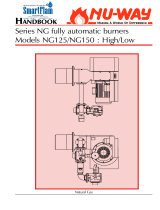18
ALPHA700
19.0 system
connections
19.1 gas connection (where appropriate)
Specific detail on the gas connection is provided by the burner manufacturer. The gas installation
pipework should be installed in accordance with the requirements of IGE/UP/2 and be tested and purged
in accordance with the requirements of IGE/UP/1.
19.2 oil connection (where appropriate)
The supply of oil to the appliance must be installed strictly in accordance with BS5410: Part 2: 1978 and
observing the instructions supplied by the burner manufacturer.
19.3 flue connection
A flue pipe of suitable material must be connected to
the flue connection at the rear of the boiler. (see fig.11)
The flue pipe must be adequately supported to avoid that
the weight of the flue system is bearing upon the boiler.
The connection of the flue pipe to the boiler must be gas
tight and include provision for disconnection. The purpose
of the flue pipe is to safely, properly and fully evacuate the
products of combustion to outside of the building and
must be properly designed - see section 16.
19.4 water connections
All Alpha 700 series boilers are provided with flow and
return connections on the rear of the back section. (see fig.12) DN100 Mating flanges for welding are
supplied complete with bolts and gaskets.
When making the flow connection, ensure flow
connection spool piece complete with thermostat pockets
is attached directly to the boiler using gasket and fixings
provided and system connection is made to the spool
piece.
A drain tapping (3/4 “ BSP-F) is provided adjacent to
the return connection. (see fig.12) The installer should
connect a short length of pipe terminating in an accessible
position with a plugged/capped full bore drain valve.
19.5 electrical connection
The boiler should be connected (as shown in section
17) using heat resisting cable tested to 160°C and suitable
for a working temperature of 70°C. The boiler should be connected using flexible multistand cables being
routed via the purpose provided grommeted cable entries at the rear face of the side casing panels. Cables
should be routed on the outside of the insulating blanket and into the control panel via the opening base
of the control panel.
Note:
Where a particular burner requires a 3 phase power supply, this should be taken via a suitable isolator
directly to the burner.
Also, where a particular burner requires a 3 phase power supply, a single phase supply plus neutral and
earth must still be connected into the boiler control panel.
Electrical installation must be in accordance with the current edition IEE Regulations.
WARNING:
This appliance MUST BE EARTHED.
fig.11
flue connection
flow connection
drain tapping
return
connection
fig.12





















